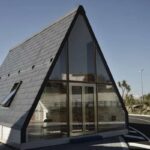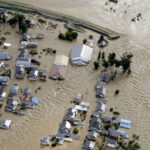Volcanoes refer to eruption of hot molten lava from below the surface of the earth. As plates move away from each other, at certain places, the surface might get stretched and thinner. In such a situation, the hot molten lava and gaseous substances below this thinned surface could open up a fissure and come out.
Typically, these eruptions are always accompanied by discharge of huge amount of gaseous substances, which are various compounds of high toxicity. All eruptions (gaseous or liquid) from a volcano is at high temperature, and, the mouth of a volcano might look like, as if it’s spewing fire.
The area around Pacific Ocean is characterized by higher volcanic activity. In fact, the entire rim along the Pacific Ocean is called as the “Ring Of Fire”, because of volcanic activity along this zone.
There are a lot of volcanic activities taking place on a continuous basis, across the globe, however, not all of these are serious enough to be termed as disasters. In fact, for most of these – just a moderate level of precaution might be sufficient.
Some of the most damaging volcanic activities of the past have been:
1. Mount Pinatubo in Phillipines (1991-96)
2. Rabaul in Papua NewGuinea (1994)
3. Lake Nyos in Cameroon (1986)
4. Nevado del Ruiz in Colombia (1985)
5. El Chichon in Mexico (1982)
Some of the deadliest volcanoes based upon the book “Volcanic Hazards: A Sourcebook on the Effects of Eruptions by Russell J. Blong (Academic Press, 1984)” are listed below. Click on the title to sort.
| Place | year | Number of deaths |
| Tambora, Indonesia | 1815 | 92000 |
| Krakatau, Indonesia | 1843 | 36417 |
| Mount Pelee, Matinique | 1902 | 29025 |
| Ruiz Colombia | 1985 | 25000 |
| Unzen Japan | 1792 | 14300 |
| Laki, Iceland | 1783 | 9350 |
| Kelut, Indonesia | 1919 | 5110 |
| Galunggung, Indonesia | 1882 | 4011 |
| Vesuvius, Italy | 1631 | 3500 |
| Vesuvius, Italy | 79 | 3360 |
| Papandayan, Indonesia | 1772 | 2957 |
| Lamington, Papua New Guinea | 1951 | 2942 |
| El Chichon, Mexico | 1982 | 2000 |
| Soufriere, St. Vincent | 1902 | 1680 |
| Oshima, Japan | 1741 | 1475 |
| Asama, Japan | 1783 | 1377 |
| Taal, Philippines | 1911 | 1335 |
Volcanoes are classified as Active, Dormant and Extinct.
● “Active” volcanoes means those which are showing activity at this time.
● “Dormant” volcanoes those which are not showing any activity at this time, but, could show activity at any time.
● “Extinct” volcanoes are those which were “active” at some time, but, have ceased volcanic eruptions now.
However, considering that volcanoes have a life of several million years, including “dormant” period of up to several thousands of years (sometimes), the above classification is mostly academic!!!
Usually, if you are staying/visiting in the vicinity of an “active” volcano, it would do good to be prepared for volcano related disasters.
There are several web-sites which give information on current volcanic activities. Some of the popular ones are – Global Volcano Report by Smithsonian Institute and Recent Earthquakes & Active Volcanoes list by Virtual Times.
Usually, most volcanoes do not result in any major disaster, and, people around areas of low volcanic activity have learnt to live with the volcanic activity. However, some of the volcanic eruptions which turn into disaster cause a very high number of fatalities, e.g. volcanic activity in Colombia in 1985 caused more than 23,000 deaths.
Besides, more often than not, volcanoes themselves might not cause any direct deaths, but, the post-volcanic complications cause more deaths. In such cases, the exact number of fatalities attributable to volcanoes can not be known for several years after the event.
Volcanoes themselves might not appear to be a big disaster, but, they cause several complications.
● Because of activities below the surface of the earth, including discharge of a huge amount of material, its possible that volcanic eruptions could be accompanied by earthquakes.
● Volcanic activity in sea could cause triggering of Tsunamis.
● Because of discharge of very high quantity of toxic material onto the landscape, sources of water like lakes/rivers etc. could get poisoned, thereby severely disrupting the water-supply. Also, the change in water composition could impact the aquatic organisms also. Thus, overall ecosystem of the water-body is misbalanced, thus, impacting the water quality. This could even impact the areas fed downstream by these same water bodies.
● Because of discharge of high amount of toxic gases in the atmosphere – the air could become highly difficult to breathe. Release of several gases – including oxides, sulfides, aerosols etc. changes the atmospheric mix of the area. These in turn can give rise to:
○ “acid rain”
○ Discharge of “aerosols” into the atmosphere alters the filtering impact of the atmosphere – for Sun’s radiation as well as for heat from the earth getting radiated back into the space. This can change the temperature of the area.
● Molten lava coming out of a volcano could reach temperatures up to 1200 degrees Celsius, thus, incernating anything that comes in its way.
● Structural damages: Lava flowing down at such a high temperature could cause structural damages
● Landslide: As lava flows down, it gets solidified, and, modifies the landscape. However, sometimes a fresh layer of lava at high temperature could destabilize the earlier solidified layer, and, that layer could simply slide off – causing a landslide.
● Lack of drinking water and breathable air causes people to migrate from their existing place of living to other places, thereby causing situations of migration, refugees. Besides, being emotionally distressful, there are severe kinds of physical stress and strain also associated with migration activities. And then, the resources at the destination side are also stretched beyond their normal capacity.
So, effectively, a volcanic activity could cause damage and loss of life due to one or more of the following:
● Contact with high temperature lava
● Earthquakes, tsunamis, landslides etc
● Poisoning of air and water
● Change in radiation levels and or toxic levels, impacting vegetation cover etc
● Post-activity starvation
● Diseases etc. due to lack of proper sanitation facilities in relief camps etc. in case large scale exodus is involved.
Even if volcanic activities do not result in too many fatalities, they still do create immense challenges in terms of humanitarian aid, due to destruction of houses, contamination of food and water. Also, one has to deal with large-scale migration, relief camps etc. which also give rise to sanitation concerns – which in turn results in various complications due to diseases related to lack of proper sanitation facilities.
During a volcanic activity, the best place to be would be indoors. Because the atmosphere is full of toxic chemicals, put filter-masks over your mouth and nose, and, use goggles to protect your eyes. Being outdoors could be one of the riskiest thing to do, as, you could be coming in contact with volcanic ashes – which could cause irritation to your eyes, skin etc. at the bare minimum, and, could also cause breathlessness, or, long term damage to you lungs, eyes etc.
Avoid weak structures, including the fresh layers which might have been formed by solidifying of lava during earlier discharges. This is usually a mistake that tourists might make. Tourists might have a tendency to get closer to the source of gaseous/lava discharge – thus, maybe, standing on such structures which are unstable and are probable to slide.
Avoid being in the path of flow of the molten lava.
Avoid fumes/vapors of petrol etc. Presence of high temperature material in the atmosphere could cause a fire, if these fumes come in contact with high temperature material, e.g. During the Nyiragongo volcanic activity (Jan. 2002), people were trying to siphon off petrol from a gas-station. A leakage came in contact with the hot lava, and, caused a blast at the gas-station, causing more than 50 people to die.
The inlets to your houses should be covered with filters, or, these inlets should be closed – to prevent toxic ashes etc. to enter your house etc. Avoid use of electronic goods, as, ashes might have entered the vent of these goods (usually provided for heat-dissipation), and, could cause short-circuit inside the devices.
Because, one of the main issues post-volcano is lack of water and food, it would help to familiarize with General Preparedeness – which also provides certain tips on being able to survive for several days – provided, preparations have been made in advance.
Post-volcano also, efforts must be made to minimize contact with the debris/ashes which have been spewed by the volcano. Clothes must be shaken and rinsed. Ashes must be vacuumed, and, the vacuum lint filter should be changed. Car filters should be changed, and so on.
If you are staying in an area, which is prone to volcanic activities, the houses should be constructed in a manner which will allow closing all vents, i.e. windows and doors should have proper caulking.


